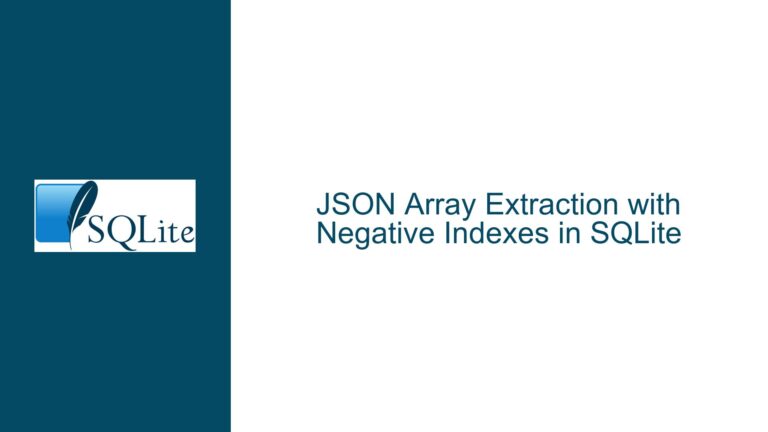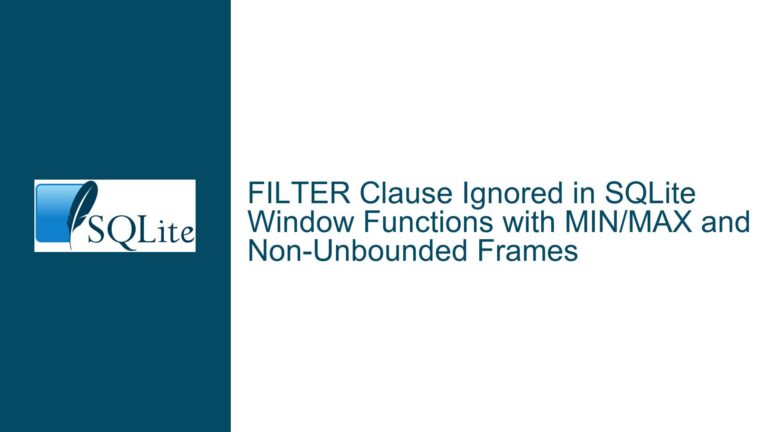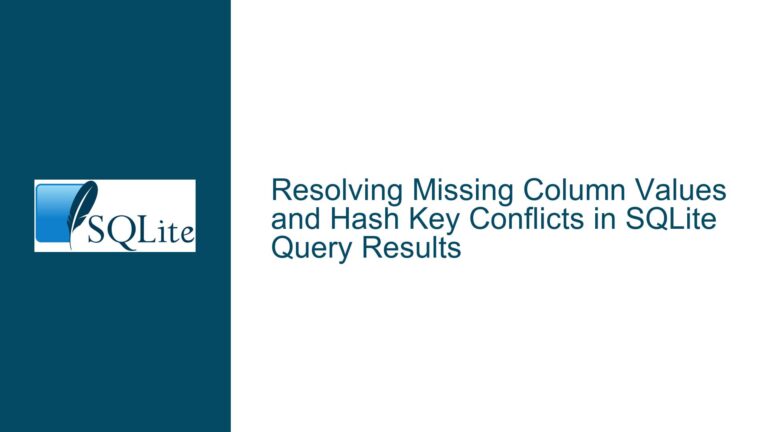Filtering SQLite Events with Refractory Periods and Max Event Selection
Understanding Event Debouncing with Time-Based Masking and Aggregation in SQLite
Event Filtering Requirements and Data Structure Challenges
The core challenge involves processing a series of timestamped events in SQLite to achieve two distinct filtering objectives. First, implement a "refractory period" where identical events within a specified time window (e.g., 5 minutes) are suppressed, while allowing different event types to appear independently. Second, create an aggregated view that selects only the maximum-value event within each time window, regardless of event type, while maintaining non-overlapping windows based on the refractory principle.
Key characteristics of the problem include:
- Out-of-order timestamps: Events arrive with arbitrary temporal sequencing
- Event type independence: Filtering logic must treat different event categories separately
- Temporal window management: Precise handling of overlapping time ranges
- Data preservation mandate: Original events must remain intact in storage
- Dual output requirements: Separate solutions needed for basic debouncing and max-event aggregation
The sample dataset demonstrates critical edge cases:
CREATE TABLE data(timestamp INTEGER, event TEXT);
INSERT INTO data VALUES
(1,'a'),(5,'b'),(2,'b'),(17,'b'),(4,'a'),(3,'c'),
(13,'a'),(16,'a'),(1,'a'),(15,'b'),(7,'b'),(10,'a'),(6,'b');
Desired output for basic debouncing shows events spaced at least 5 units apart within their categories:
1 | a
2 | b
3 | c
7 | b
10 | a
15 | b
16 | a
Max-event aggregation requires:
1 | c
6 | b
13 | b
Limitations of Naive Filtering Approaches and Subquery Pitfalls
Initial attempts using correlated subqueries to count preceding events within the time window face fundamental limitations:
Problem 1: Recursive Masking Dependencies
Simple row counting ignores whether preceding events are themselves masked. This creates false positives because suppressed events still appear to "mask" subsequent entries. The query:
SELECT timestamp, event,
(SELECT COUNT(*) FROM data d
WHERE d.timestamp BETWEEN a.timestamp-5 AND a.timestamp) AS masked
FROM data a
Produces incorrect masking counts because it includes all temporal predecessors regardless of their masked status.
Problem 2: Event-Type Isolation Failure
Basic window functions like ROW_NUMBER() partitioned by event type fail when events are inserted out-of-order. The sequence:
1 (a) → 2 (b) → 4 (a)
Would incorrectly allow the 4 (a) through if sorted improperly, despite being within 5 units of 1 (a).
Problem 3: Window Frame Boundary Confusion
Attempts using RANGE clauses with PRECEDING/FOLLOWING struggle with:
- Mixed event types requiring separate window partitions
- Variable window sizes based on actual event timestamps rather than fixed row counts
- Handling identical timestamps for different events
Problem 4: Max-Event Selection Complexity
Aggregate queries with GROUP BY on time windows fail because:
- Traditional fixed-size windows (e.g., 5-unit buckets) don’t align with event-driven refractory periods
- Maximum value selection must consider dynamically shifting windows based on prior selections
Recursive CTE Solutions for Event Sequencing and Window Management
Solution 1: Event-Specific Debouncing with Recursive Filtering
This approach uses a recursive CTE to build valid event sequences per category:
WITH RECURSIVE event_sequence AS (
-- Anchor: First event of each type
SELECT event, MIN(timestamp) AS timestamp
FROM data
GROUP BY event
UNION ALL
-- Recursive: Next valid event per type
SELECT e.event,
(SELECT MIN(timestamp)
FROM data
WHERE event = e.event
AND timestamp >= e.timestamp + 5)
FROM event_sequence e
WHERE EXISTS (
SELECT 1 FROM data
WHERE event = e.event
AND timestamp >= e.timestamp + 5
)
)
SELECT * FROM event_sequence ORDER BY timestamp;
Mechanics:
- Anchor Member: Starts with earliest occurrence per event type
- Recursive Member: Finds next event in same category ≥5 units later
- Termination Condition: EXISTS ensures recursion stops when no more valid events
Solution 2: Event-Agnostic Max-Event Selection
For aggregated max-event selection with shifting windows:
WITH RECURSIVE max_windows AS (
SELECT
timestamp,
(SELECT MAX(event) FROM data
WHERE timestamp BETWEEN a.timestamp AND a.timestamp+5) AS max_event
FROM data a
WHERE timestamp = (SELECT MIN(timestamp) FROM data)
UNION ALL
SELECT
(SELECT MIN(timestamp) FROM data
WHERE timestamp > m.timestamp + 5),
(SELECT MAX(event) FROM data
WHERE timestamp BETWEEN (SELECT MIN(timestamp) FROM data
WHERE timestamp > m.timestamp + 5)
AND (SELECT MIN(timestamp) FROM data
WHERE timestamp > m.timestamp + 5) + 5)
FROM max_windows m
WHERE m.timestamp IS NOT NULL
)
SELECT timestamp, max_event
FROM max_windows
WHERE max_event IS NOT NULL;
Key Features:
- Window Propagation: Each window starts immediately after prior window ends
- Dynamic MAX() Calculation: Re-evaluates max event within each new window
- Termination Handling: NULL checks prevent infinite recursion
Optimization Strategies and Edge Case Handling
Indexing Requirements
Create composite index for temporal event queries:
CREATE INDEX idx_data_event_time ON data(event, timestamp);
Duplicate Timestamp Resolution
Explicit ordering for identical timestamps:
SELECT MIN(rowid) FROM data
WHERE timestamp = target_time
GROUP BY timestamp, event;
Temporal Boundary Conditions
Handle edge cases with inclusive/exclusive bounds:
WHERE d.timestamp >= anchor_time
AND d.timestamp < anchor_time + 5 -- Exclusive upper bound
Parameterization
Wrap solutions in stored procedures for window size flexibility:
CREATE TEMP TABLE debounce_params (window_size INTEGER);
INSERT INTO debounce_params VALUES (5);
-- Use in CTE:
WHERE timestamp >= e.timestamp + (SELECT window_size FROM debounce_params)
Performance Considerations
- Materialized Intermediate Results: Store recursive CTE output in temp tables
- Batch Processing: Segment large datasets using timestamp ranges
- Explain Plan Analysis: Use SQLite’s EXPLAIN QUERY PLAN to optimize index usage
Alternative Approaches and Compatibility Considerations
Temporal Table Functions
For SQLite installations with extension support, implement a generate_series-like function to create time buckets:
SELECT
bucket,
(SELECT MAX(event) FROM data
WHERE timestamp BETWEEN bucket AND bucket + 5) AS max_event
FROM (
SELECT DISTINCT timestamp - (timestamp % 5) AS bucket
FROM data
)
Trigger-Based Preprocessing
Maintain a shadow table with validity flags using triggers:
CREATE TABLE data_processed (
timestamp INTEGER,
event TEXT,
is_valid BOOLEAN,
window_end INTEGER
);
CREATE TRIGGER flag_events AFTER INSERT ON data
BEGIN
UPDATE data_processed
SET is_valid = CASE
WHEN NEW.timestamp >= window_end THEN 1
ELSE 0
END
WHERE event = NEW.event;
INSERT INTO data_processed
SELECT NEW.timestamp, NEW.event, 1, NEW.timestamp + 5;
END;
Application-Side Comparison
While the original question specifies SQL-only solutions, hybrid approaches using SQL window functions with application logic may be appropriate for complex scenarios:
- Retrieve candidate events with dense rankings
- Apply custom filtering logic in application code
- Batch update validity status in database
Diagnostic Queries and Validation Techniques
Validation Query 1: Event Sequence Verification
WITH processed AS (
-- Insert recursive CTE here --
)
SELECT event, timestamp,
timestamp - LAG(timestamp, 1, -5) OVER (PARTITION BY event ORDER BY timestamp) AS gap
FROM processed
WHERE gap < 5; -- Should return no rows
Validation Query 2: Max Event Coverage Check
WITH windows AS (
SELECT timestamp AS start, timestamp + 5 AS end
FROM max_windows
)
SELECT d.*
FROM data d
WHERE NOT EXISTS (
SELECT 1 FROM windows w
WHERE d.timestamp BETWEEN w.start AND w.end
AND d.event <= (SELECT max_event FROM windows w2
WHERE w2.start = w.start)
);
-- Should return no rows if all events are properly masked
Temporal Coverage Analysis
SELECT
m.timestamp AS window_start,
m.timestamp + 5 AS window_end,
COUNT(d.timestamp) AS events_in_window,
MAX(d.event) AS actual_max
FROM max_windows m
LEFT JOIN data d ON d.timestamp BETWEEN m.timestamp AND m.timestamp + 5
GROUP BY m.timestamp;
-- Compare actual_max with max_windows.max_event
Migration Considerations and Version-Specific Behaviors
SQLite Version Feature Requirements
- Recursive CTEs: Requires SQLite 3.8.3+ (2014-02-03)
- Window Functions: Available in 3.25.0+ (2018-09-15) for ROW_NUMBER() approaches
- Index Skip Scan: Optimizer improvement in 3.30.0 (2019-10-04) benefits event-timestamp queries
Backwards Compatibility Strategies
For pre-3.8.3 environments, implement recursive logic through:
- Temporary tables with iterative updates
- Application-side recursion with batched queries
- SQLite C extension implementing recursive operations
Storage Optimization
Convert recursive CTE results to materialized views:
CREATE TABLE debounced_events AS
-- Recursive CTE query here--;
Create triggers to maintain materialized views:
CREATE TRIGGER refresh_debounced AFTER INSERT ON data
BEGIN
DELETE FROM debounced_events;
INSERT INTO debounced_events
-- Recursive CTE query here--;
END;
Conclusion and Final Recommendations
The recursive CTE approach provides the most robust solution for SQLite-based event debouncing requirements. Key implementation guidelines include:
Event-Specific Filtering
- Use separate recursive CTEs per event category
- Implement composite indexes on (event, timestamp)
- Validate with gap analysis between consecutive events
Max-Event Aggregation
- Maintain window state in recursive CTE
- Combine MIN(timestamp) lookups with MAX(event) selection
- Verify complete temporal coverage of source data
Performance Tuning
- Analyze query plans with EXPLAIN QUERY PLAN
- Experiment with INDEXED BY clauses for large datasets
- Consider partial indexes for active time ranges
Maintenance Strategy
- Schedule VACUUM operations after bulk inserts
- Monitor sqlite_stat1 table for optimizer statistics
- Use WAL mode for concurrent read/write access
For mission-critical implementations, supplement SQLite operations with application-level checks to handle edge cases like clock skew and duplicate event suppression. Periodically revalidate filtering logic against updated datasets using the diagnostic queries provided.






